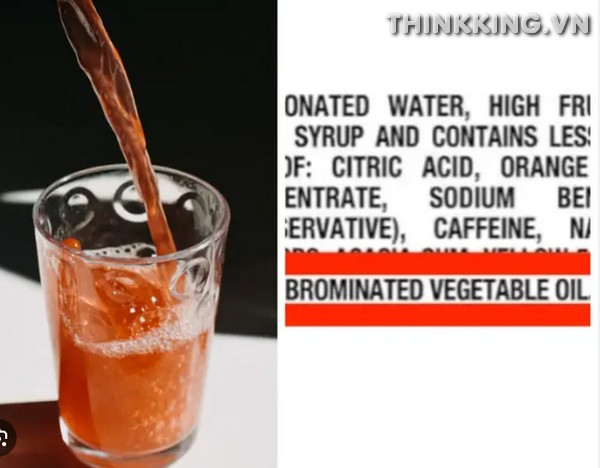Brominated Vegetable Oil Soda: Unraveling the Controversy
Welcome to Thinkking.vn, your trusted source for insightful articles and information. Today, we embark on a fascinating exploration of Brominated Vegetable Oil Soda, where we will delve into its definition, trace its historical significance in the world of soft drinks, and shed light on the current concerns and regulatory actions that are shaping the conversation. Join us as we unravel the complexities of BVO in the realm of beverages and gain a deeper understanding of its impact on our daily choices. Stay tuned for an enlightening journey ahead
I. What Brominated Vegetable Oil (BVO) Is and Its Role in Soft Drinks
Brominated Vegetable Oil (BVO) is a food additive that has garnered significant attention due to its presence in soft drinks. Understanding what BVO is and why it is commonly combined with soft drinks is essential to grasp its impact on the beverage industry.

1. Definition of Brominated Vegetable Oil (BVO)
BVO is a complex mixture of plant-derived triglycerides that have undergone a chemical modification process involving the element bromine. This modification results in bromine atoms being bonded to the triglyceride molecules. The outcome is a substance that can be used as an emulsifier and stabilizer in food and beverages, including soft drinks.
2. Why BVO Is Often Combined with Soft Drinks
BVO is primarily utilized in soft drinks to serve as an emulsifier, a crucial component in ensuring that the various ingredients in these beverages remain well-mixed and consistent. Specifically, in citrus-flavored soft drinks, BVO is employed to prevent the separation and floating of flavoring agents to the top of the liquid. This ensures that the taste and appearance of the soft drink are uniform throughout its shelf life.
In essence, BVO helps maintain the desired flavor profile and visual appeal of citrus-flavored soft drinks, making it an integral ingredient in this category of beverages.
Understanding BVO’s role in soft drinks sets the stage for a deeper exploration of its historical use, regulatory developments, health concerns, and the future outlook for this controversial food additive.
II. BVO Usage in Soft Drinks: Understanding the Role of Brominated Vegetable Oil Soda
When it comes to the world of soft drinks, understanding the role of Brominated Vegetable Oil (BVO) is essential. In this section, we’ll delve into its significance as an emulsifier, the ingenious mechanism it employs to prevent flavor separation, and the common soft drink brands that have historically incorporated BVO.

BVO as an Emulsifier in Citrus-Flavored Beverages
Brominated Vegetable Oil Soda has long been employed as an emulsifier, particularly in citrus-flavored beverages. But what exactly does this mean? BVO plays a critical role in these drinks by ensuring that various components, including oils and flavorings, remain evenly distributed throughout the liquid. This process is vital to maintain the desired taste and texture of these beverages.
Mechanism of Preventing Flavor Separation
To grasp the significance of BVO, it’s important to comprehend the mechanism behind its action. Brominated Vegetable Oil works by increasing the density of the beverage, making it heavier than the flavorings and oils it contains. As a result, these components remain suspended in the liquid rather than separating and floating to the top. This ingenious method is key to providing consumers with the consistent and enjoyable taste they expect from their favorite citrus-flavored soft drinks.
Common Soft Drink Brands That Used BVO
Throughout its history, several prominent soft drink brands have utilized Brominated Vegetable Oil Soda in their products. These brands recognized the value of BVO in maintaining the quality and consistency of their citrus-flavored beverages. While some have continued to use it, others have opted for alternative ingredients in response to changing consumer preferences and regulatory developments.
III. Regulatory Actions: The Evolution of Brominated Vegetable Oil Soda Oversight
The journey of Brominated Vegetable Oil Soda has been marked by a series of regulatory actions that have shaped its presence in the beverage industry. In this section, we’ll navigate through the key milestones in its regulatory history, from initial recognition to recent proposals for change.
FDA’s Initial Recognition of BVO as “Generally Recognized as Safe” (GRAS)
Originally, the FDA recognized Brominated Vegetable Oil (BVO) as “Generally Recognized as Safe” (GRAS). This classification allowed its widespread use as an emulsifier in beverages, particularly in citrus-flavored drinks. GRAS status indicated that BVO was considered safe for consumption based on available knowledge at that time.
FDA’s Withdrawal of GRAS Status in 1970
However, in 1970, a significant turning point occurred. The FDA withdrew BVO’s GRAS status, signaling a shift in the perception of its safety. This decision stemmed from emerging concerns and new scientific findings that raised questions about the potential health risks associated with BVO consumption.
California’s Ban on BVO in October 2023
California, known for its stringent food safety regulations, took a bold step in October 2023 by banning Brominated Vegetable Oil Soda within its borders. This move marked the first state-level prohibition of BVO in the United States, reflecting the growing concerns regarding its safety and impact on public health.
BVO Ban in Europe and Japan
It’s essential to note that California’s ban wasn’t an isolated action. Prior to this, both Europe and Japan had already implemented bans on BVO. These international decisions further underscored the global recognition of potential health risks associated with BVO consumption.
Recent FDA Proposal to Revoke Authorization for BVO in Food
In the United States, the FDA has continued to monitor and assess the safety of food additives. In a recent development, the FDA proposed revoking its authorization for the use of BVO in food products, including Brominated Vegetable Oil Soda. This proposal is based on findings from studies, including those conducted in collaboration with the National Institutes of Health, which indicated the potential for adverse health effects in humans.
IV. Health Concerns: Delving into Brominated Vegetable Oil Soda’s Impact
The consumption of Brominated Vegetable Oil Soda has raised a range of health concerns, sparking debates and discussions within both the scientific community and the public. In this section, we will explore the reported health hazards linked to BVO consumption, the adverse effects it may have on critical bodily systems, and the worrisome accumulation of BVO in the human body over time.
Reported Health Hazards Associated with BVO Consumption
Numerous reports and studies have emerged highlighting potential health hazards linked to the consumption of beverages containing Brominated Vegetable Oil. These concerns have led to increased scrutiny and calls for further investigation into its safety. Understanding these reported hazards is essential for making informed choices regarding BVO-containing products.
Adverse Effects on the Nervous System, Thyroid Gland, and Other Organs
One of the key areas of concern regarding Brominated Vegetable Oil Soda is its potential adverse effects on the human body. Studies have indicated that BVO consumption may have negative repercussions on the nervous system, potentially leading to issues such as headaches, memory loss, and muscle coordination problems. Furthermore, there are suggestions of BVO’s impact on the thyroid gland, which plays a crucial role in regulating various bodily functions, including blood pressure, heart rate, and metabolism.
Accumulation of BVO in the Body Over Time
Another aspect that has raised alarms is the accumulation of Brominated Vegetable Oil in the body over time. Unlike some substances that are easily eliminated by the body, BVO appears to linger and accumulate in bodily tissues. This persistence has sparked concerns about the long-term effects of continuous BVO exposure and the potential health risks associated with its gradual buildup.
As we navigate the intricate landscape of Brominated Vegetable Oil Soda, it’s crucial to stay informed about the ongoing research and discussions surrounding its health implications. The information gathered here will empower you to make educated choices regarding your beverage preferences and overall well-being.
V. Industry Response and Alternatives: Shaping the Future of Brominated Vegetable Oil Soda
The presence of Brominated Vegetable Oil Soda in the beverage industry has prompted both consumer awareness and industry responses. In this section, we will explore how beverage companies have reacted, their reformulation efforts to replace BVO, shining examples of companies that have removed BVO from their products, and alternative food additives employed for emulsification.
Beverage Companies’ Reformulation Efforts to Replace BVO
In response to growing concerns and shifting consumer preferences, numerous beverage companies have embarked on reformulation efforts. Their goal: to replace Brominated Vegetable Oil with alternative ingredients that meet the demands for both safety and product quality. This proactive response demonstrates the industry’s commitment to addressing consumer concerns.
Examples of Companies That Removed BVO from Their Products
Several prominent companies have taken decisive steps to eliminate BVO from their beverage offerings. Leading by example, they’ve recognized the importance of aligning their products with evolving health standards and consumer expectations. Their actions have set a precedent for others in the industry to follow suit.
Alternative Food Additives for Emulsification
As beverage companies seek alternatives to BVO, a range of food additives for emulsification has come to the forefront. These additives serve the critical role of maintaining product consistency without the potential health risks associated with BVO. Exploring these alternatives provides insights into the innovative solutions that are shaping the future of the beverage industry.
Understanding the industry’s response and the viable alternatives available for emulsification offers consumers a broader perspective on the choices they have when it comes to their preferred beverages. Stay informed as we uncover the evolving landscape of Brominated Vegetable Oil Soda and the changes shaping its future.
VI. Conclusion and Future Outlook: Navigating the Path Forward with Brominated Vegetable Oil Soda
As we near the conclusion of our journey through the realm of Brominated Vegetable Oil Soda, it’s essential to reflect on the role of regulatory bodies, the pending decisions that may reshape the industry, and the recommendations that empower consumers to make informed choices.
FDA’s Role in Monitoring and Regulating Food Additives
The FDA plays a pivotal role in ensuring the safety of food additives, including those found in beverages like Brominated Vegetable Oil Soda. Their continuous monitoring and regulatory actions reflect their commitment to safeguarding public health. Understanding the FDA’s role provides insight into the mechanisms that govern food safety in the United States.
Pending Final Decision on BVO’s Ban
The future of Brominated Vegetable Oil Soda is uncertain, with a pending decision regarding its ban. This decision will have far-reaching implications for the beverage industry and consumer choices. Staying informed about the outcome of this decision is crucial, as it may shape the availability and composition of your favorite beverages.
Recommendations for Consumers to Check Product Labels for BVO Content
In light of the ongoing discussions and regulatory developments, it’s prudent for consumers to take an active role in their beverage choices. Checking product labels for BVO content empowers individuals to make informed decisions about the beverages they consume. By being vigilant and aware of what’s in the products they purchase, consumers can prioritize their health and well-being.
As we conclude our exploration of Brominated Vegetable Oil Soda, we encourage you to stay engaged with the evolving landscape of food additives and their impact on the beverage industry. Your awareness and informed choices can contribute to a safer and healthier future in the world of beverages.










